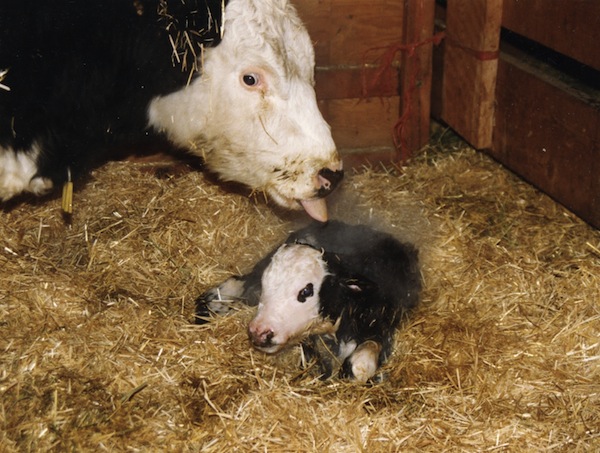It is generally accepted that adequate supervision at calving has a significant impact on reducing calf mortality. Adequate supervision has been of increasing importance with the use of larger beef breeds and cattle with larger birth weights. On most ranching operations, supervision of the first calf heifers will be best accomplished in daylight hours and the poorest observation takes place in the middle of the night.
The easiest and most practical method of inhibiting nighttime calving at present is by feeding cows at night; the physiological mechanism is unknown, but some hormonal effect may be involved. Rumen motility studies indicate the frequency of rumen contractions falls a few hours before parturition. Intraruminal pressure begins to fall in the last 2 weeks of gestation, with a more rapid decline during calving. It has been suggested that night feeding causes intraruminal pressures to rise at night and decline in the daytime.
In a Canadian study of 104 Hereford cows 38.4% of a group fed at 8:00 am and again at 3:00 pm delivered calves during the day, 79.6% of a group fed at 11:00 am and 9:00 pm. A British study utilizing 162 cattle on 4 farms compared the percentages of calves born from 5:00 am to 10:00 pm to cows fed at different times. When cattle were fed at 9:00 am, 57% of the calves were born during the day, vs 79% with feeding at 10:00 pm. In field trials by cattlemen utilizing night feeding when 35 cows and heifers were fed once daily between 5:00 pm and 7:00 pm, 74.5% of the calves were born between 5:00 am and 5:00 pm. In the most convincing study to date, 1331 cows on 15 farms in Iowa were fed once daily at dusk, 85% of the calves were born between 6:00 am and 6:00 pm. Whether cows were started on the night feeding the week before calving started in the herd or 2 to 3 weeks earlier made no apparent difference in calving time.
Various means have been employed to effectively reduce animal loss at calving time. Skilled personnel should be available to render obstretric assistance and neonatal care to maximize percentage calf crop weaned in the cattle operation. Currently, evening feeding of cattle seems to be the most effective method of scheduling parturition so assistance can be available during daylight hours.
The percentage of adult mature cows that need assistance at calving is extremely low compared to the percentage of first calf heifers. Therefore, the heifers, of course, are the group of females that are of greatest need of observation during the calving season. On many large ranches, it is physically impossible to feed all of the cows after 5:00 pm. In those instances, the ranch manager should plan to feed the mature cows earlier in the day, then feed the first calf heifers at dusk.
What about the situation where large round bales of hay are being fed to the cows and heifers? If the cows have unrestricted access to the hay around the clock, then the best method of influencing the time of calving is via the time of day that the supplement is being fed. At Oklahoma State University, the switch from supplement feeding in daytime to late afternoon/early evening feeding encouraged 72% of the cows to calve between 6 AM and 6 PM. These cows had 24/7 access to large round bales of grass hay. Before the change was made, when supplement was fed during the morning hours, the ratio of night time versus day time calving was nearly even, with half of the calves born at night and half during the day.
Some ranchers (usually with small herds) have reported success controlling access to the large round bales. The hay is fed within a small enclosed pasture or lot near a larger pasture where the cows graze during the day. In the evening, the gate to the area where the hay is placed is opened and the cows are allowed to enter and consume hay during the night. The next morning, they are moved back to the daytime pasture to graze until the following evening. In this manner, the nighttime feeding is accomplished with hay or silage only.
Whatever method fits your operation should be utilized. The advantages of heifers/cows being observed with daylight during calving is obvious. Also during winter months, baby calves born in the warmer part of the day with radiant heat from the sun to reduce cold stress, have a better chance for early colostrum consumption and therefore survival.

Source: Drovers Cattle Network















